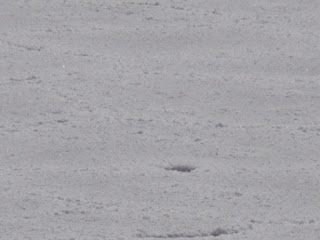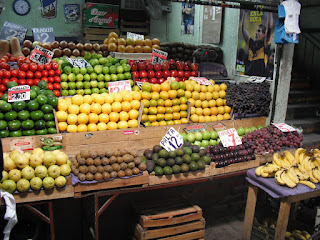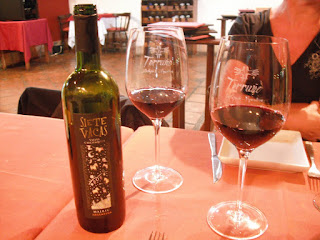We have left Chos Malal to head out to Malargue. On the way, again on the 40, we have another 100 kms of gravel/stone road. We will drive by "Rio Grande', a small river who dug a canyon in the volcanic rock.
In Malargue, we end up in the municipal camping, yes, we are trying again at the cost of 30 pesos ($7.50 a night). We meet there a couple, Brigit and Dieter with their camper, that we had seen about a month ago in Punta Pyramides. It's a small world! We are happy to share a bottle of wine and our experiences in Argentina...
The night was chilly... We decide to fold the tent for the following night. We meet an Argentinian guide, Isoaias to go see the inside of a volcano, the Volcano Mallalarca. We saw the 2 chimneys of the volcano. Pretty impressive !
We then head out to Los Molles and Las Lenas, a ski resort, famous for its dry powder due to the climate around here. As usual, the road is stunning. It's a shame that it is very difficult to show on the pictures the reach tones of colours as well as the perspective we experiment every time. On our way back, we stop to check out a geological curiosity, Pozo Los Animas. A must see !
After a long day, it's restaurant time and we decide to give the Parilla another try at El Quincho de Mario, recommended by Lonely Planet ! Although it looks good,
Big mistake : the meat is hard and one more time we are disappointed. One interesting thing about restaurants in Argentina, first of all, is that most people do arrive after 10 pm and most of the time, with the kids, no matter the age... It certainly would not be acceptable in restaurants in France, but here, it is absolulely part of the culture. We have seen it all around Argentina, sofar and no clients complain, the waiters are also eager to take care of the little fellows and provide high chairs, when required. That evening, I decided that I needed to eat some green and opted for a vegetarian dish. In my mind, vegetarian goes with healthy. Another mistake, I saw a zucchini dish arrive, but ... fried... Just thinking that Alain wanted to add some French fries, we would have had another balanced meal!
We leave the following day towards Mendoza. We have now driven 3000 kms on Ruta 40.
We visit on the way the Canyon del Atuel, compared by the locals in Argentina to Gran Canyon in Arizona. 67 kms long, on another gravel road, of course, we discover incredible scenery with multicolored layers of rocks as well as weird shapes.



The day comes to an end, the local campground in San Carlos is closed and we don't know where to stop. Once again, we decide to ask the locals. I see a nice little house on the side of the gravel road, an elderly man watering his plants and I ask Alain to stop. With my best ''Castillano", I give a twik to my usual story by stating that the camping is closed (which is true) : ''El camping es cerrado, somos Turistas de Canada y buscamos un sitio por acampar''. He does not seem to understand and soon comes back with a lady. I explain again my sales pitch and after convincing her in Spanish that we are good guys, they accept to host us on their property for one night. Afterwards, I learnt that the gentleman, Jose, is a little deaf (my Spanish has improved indeed). It has been more difficult than in Chile to be accepted on their property and we learnt afterwards, that it was for security reasons. However, we have the feeling that these folks are warry of anyone coming from big cities. They will warn us later against Buenos Aires, Mendoza... However, now that they have accepted us and opened they door, they open their heart ! They all want to make sure that we are okay, introduce us to all of their family members. They allow us to put our table under their patio, use the table, we have access to our own washrooms and welcome to take a shower the following morning.
Thank you Maria and Jose ! We are so lucky to meet people like them ! it's part of the experience !
We are On the Road Again to the valley of Uco, a few kilometers before Mendoza. We will stop at a Bodega : Francois Lurton, who owns different wineries throughout the world ! We will then decide to visit the Bodega Salentein owned by some Hollanders. They started their winery in 1973 and built the main building in 2000. The size of the wineyard is 2000 hectares, spread on three different altitudes (1300, 1500 and 1700 m) a little mind buggling for any French person...They have now 3000 barrils (90% French oak) that they store around the auditorium. The humidity is controlled within the buildings and the temperature is stable at 12 degrees. They mainly grow Malbec, Cabernet Sauvignon and Chardonnay. They have planted roses at the start of each row of grapes, and the colour of the roses help determine the degree of maturity of the wines.
And of course, it is time for another tasting experience : Cheers everybody !
In Maipu, we are camping again and the following day we decide to go see the ''roof of the Americas'', the Aconcagua at 6962 meters. Again, we have a blue sky, an ideal temperature and we start driving along this windy road, very scenic again... The colours are wonderful, reddish, yellowish, brownish, with the green and yellow of the vegetation along the way. We stop at the Puente del Inca
and a few kilometers further, we are stunned by the beauty of the Aconcagua. We hike only for about 2 1/2 hours from 2800 meters to 3200 meters, but it's already late and we turn around.
We stop at the Cemetary of the Andinists. There lay all the alpinists that died while living their passion and we must admit that we are completely moved... time to go !
We visit the following day a plant of olive oil, LAUR. It was started in 1906 by a French guy Francisco Laur. Short visit but interesting nonetheless. They have over 1500 olive trees over 100 years old. Each tree produce about 100 kgs of olives every year. And yes, we get to taste the olive oil this time !
We then visit another Winery, Carinae owned by a French couple who decided to change their lives about 8 years ago. Their winery is much different than Salentein as their winery spreads on only 12 hectares. We get to select our ''tasting'' menu this time !
Cheers again !
We decide not to stop in Mendoza itself in the end and will be On the Road Again.... tomorrow


































































